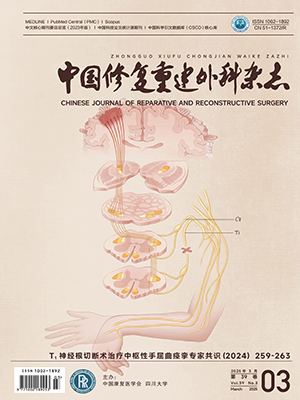| 1. |
Eckardt A, Swennen G, Teltzrow T. Melanotic neuroectodermal tumor of infancy involving the mandible:7-year follow-up after hemimandibulectomy and costochondral graft reconstruction. J Craniofac Surg, 2001, 12(4):349-354.
|
| 2. |
Dimitroulis G. Mandibular reconstruction following ablative tumour surgery:an overview of treatment planning. Aust N Z J Surg, 2000, 70(2):120-126.
|
| 3. |
Shvyrkov MB, Shamsudinov AKh, Sumarokov DD, et al. Non-free osteoplasty of the mandible in maxillofacial gunshot wounds:mandibular by reconstruction by compression-osteodistraction. Br J Oral Maxillofac Surg, 1999, 37(4):261-267.
|
| 4. |
Bell RB. Computer planning and intraoperative navigation in cranio-maxillofacial surgery. Oral Maxillofac Surg Clin North Am, 2010, 22(1):135-156.
|
| 5. |
Balasundaram I, Al-Hadad I, Parmar S. Recent advances in reconstructive oral and maxillofacial surgery. Br J Oral Maxillofac Surg, 2012, 50(8):695-705.
|
| 6. |
Hassfeld S, Mühling J. Computer assisted oral and maxillofacial surgery-a review and an assessment of technology. Int J Oral Maxillofac Surg, 2001, 30(1):2-13.
|
| 7. |
吴锦阳, 桂海军, 张诗雷, 等. 计算机辅助导航技术在颞下颌关节侧方成形术中的应用. 组织工程与重建外科杂志, 2014, 10(1):43-46.
|
| 8. |
于洪波, 王旭东, 张诗雷, 等. 计算机辅助导航技术在上颌骨肿瘤切除及缺损重建中的应用. 中国口腔颌面外科杂志, 2013, 11(6):472-476.
|
| 9. |
于洪波, 张诗雷, 王旭东, 等. 计算机辅助导航技术在口腔颌面外科中的应用——104例病例分析. 上海口腔医学, 2012, 21(4):416-421.
|
| 10. |
廖贵清, 苏宇雄. 下颌骨缺损分类. 广东牙病防治, 2008, 16(2):57-59.
|
| 11. |
Luebbers HT, Messmer P, Obwegeser JA, et al. Comparison of different registration methods for surgical navigation in cranio-maxillofacial surgery. J Craniomaxillofac Surg, 2008, 36(2):109-116.
|
| 12. |
Eggers G, Mühling J, Marmulla R. Image-to-patient registration techniques in head surgery. Int J Oral Maxillofac Surg, 2006, 35(12):1081-1095.
|
| 13. |
Chiu WK, Luk WK, Cheung LK. Three-dimensional accuracy of implant placement in a computer-assissted navigation system. Int J Oral Maxillofac Implants, 2006, 21(3):465-470.
|
| 14. |
蔡志刚. 数字化外科技术在下颌骨缺损修复重建中的应用. 中华口腔医学杂志, 2012, 47(8):474-478.
|
| 15. |
Bell RB, Weimer KA, Dierks EJ, et al. Computer planning and intraoperative navigation for palatomaxillary and mandibular reconstruction with fibular free flaps. J Oral Maxillofac Surg, 2011, 69(3):724-732.
|
| 16. |
刘筱菁, 贺洋, 巩玺, 等. 计算机导航技术在口腔颌面部创伤整复中的应用. 中华口腔医学杂志, 2012, 47(11):645-650.
|
| 17. |
于洪波, 沈国芳, 张诗雷, 等. 计算机辅助导航外科在颞下颌关节成形术中的应用. 上海口腔医学, 2008, 17(5):452-456.
|
| 18. |
Marmulla R, Mühling J, Lüth T, et al. Advanced surface-recording techniques for computer-assisted oral and maxillofacial surgery. Br J Oral Maxillofac Surg, 2004, 42(6):511-519.
|
| 19. |
高涛, 富建明, 楼勇贞, 等. 应用计算机辅助手术导航系统治疗单侧颧骨复合体骨折. 中华口腔医学杂志, 2012, 47(4):238-240.
|
| 20. |
Schep NW, Broeders IA, van der Werken C. Computer assisted orthopaedic and trauma surgery. State of the art and future perspectives, Injury, 2003, 34(4):299-306.
|




